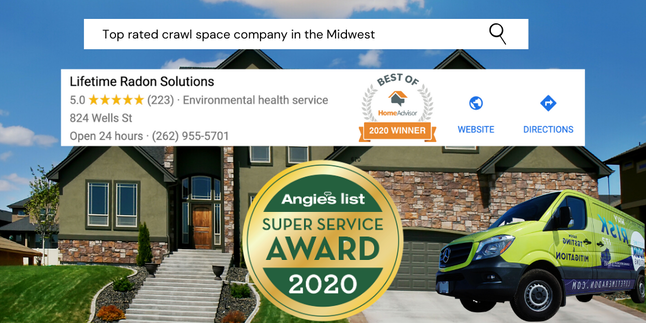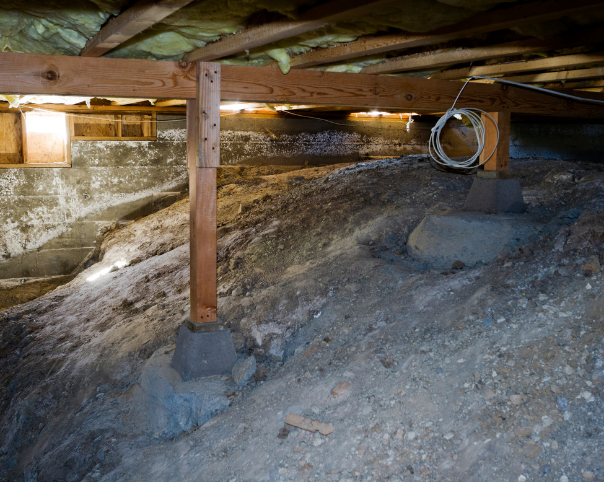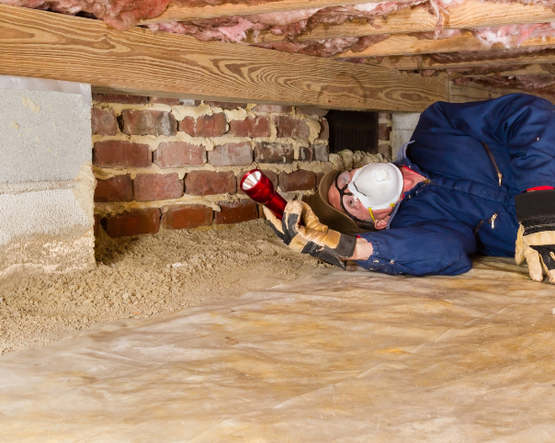Crawl Space EncapsulationIt is estimated that 40-50% of household air can rise up from a home's open crawl space. With that being said, the majority of homes with an open crawl space do not have soil that is completely dry, or free from dangerous soil vapors, so it is vital to keep any crawl space dry and clean by having it properly sealed and ventilated. In Wisconsin and Northern Illinois, mold, mildew, and other microbial growths are common in uncovered crawl spaces due to the amount of moisture in the soil. Additionally, with the presence of elevated radon gas levels in the area and VOC's such as TCE lurking within the soil, you can take a big step in protecting your home by sealing off the largest possible entry point. Crawl space encapsulation will not only keep your home smelling fresh, but also contribute in keeping your radon levels low and certain pests out.
Benefits of Crawl Space Encapsulation
Crawl Space Sealing and Repair |
|
|
As mentioned above, to effectively improve the indoor air quality of a home with a crawl space, it must be sealed and ventilated properly. Simply using a dehumidifier or a fan to keep that space dry will not ultimately solve the potential issues an open crawl space presents. Moisture and dangerous soil vapors such as radon and certain VOC's must be stopped at the source. Every home is different when it comes to the techniques needed to create a safe and dry crawl space. In addition to sealing crawl spaces down with a strong and durable vapor barrier, Lifetime Radon Solutions also offers sub-membrane depressurization systems to work with the initial encapsulation project. Sub-membrane depressurization systems draw the rising moisture and soil gasses out from under the sealed vapor barrier to properly remove them from the home entirely. Sub-membrane depressurization systems when used in tandem with a crawl space encapsulation project can remove 2-4 tons of moisture every year from the home.
|
If your home already has a sealed crawl space but the barrier has become torn or damaged in any way, Lifetime Radon Solutions also offers crawl space repair services. We will come to you home free of charge and analyze each and every issue with your current barrier or SMD system and give you a fair price for repair within 24 hours. Give us a call now to set up an appointment!
Crawl Space Encapsulation Companies

When it comes to indoor air quality issues, choosing the right contractor to help with your home is of utmost importance. Crawl space encapsulation solutions should last for decades to come, so choosing a company who has decades of experience with these services is a good place to start. In addition to experience, you should research the type of materials the company uses to complete their encapsulation and venting services. At Lifetime Radon we most commonly use 12 mm cross laminate sheeting for the sealing of a crawl space, but we have access to a multitude of other materials and thicknesses if you prefer or require them. For sub-membrane depressurization systems, we use the best mitigation fans on the market (Festa AMG) which are German engineered and assembled right here in the US, and we use cellular core 40 PVC piping to route the rising soil vapors out.
Lastly, check for online reviews on Google, Home Advisors, Angies List, and the Better Business Bureau to make sure that you will receive the best possible care when it comes to your home. Give us a call today for a free estimate!
Lastly, check for online reviews on Google, Home Advisors, Angies List, and the Better Business Bureau to make sure that you will receive the best possible care when it comes to your home. Give us a call today for a free estimate!
Crawl Space Encapsulation Cost
|
Every crawl space encapsulation project and sub-membrane depressurization system must be custom designed and implemented to fit each and every home. For this reason, crawl space encapsulation is not a one price fits all type of project.
The pricing for a crawl space solution in your home largely depends on a few different factors which include:
With those factors considered, the average cost of a crawl space encapsulation project according to HomeAdvisor is $5,500 with the range being $1,500 to $15,000. |
FAQ's
What is Crawl Space Encapsulation?
Crawl Space encapsulation is the process of sealing off a potentially wet, dirty, moldy crawl space and turning it into a clean and dry space where mold growth cannot start. There are multiple methods used to complete this process, but the most common is to seal a vapor barrier to the floor and walls. Other methods can include sub-membrane depressurization and total encapsulation including the ceiling.
How Long Does the Encapsulation Process Take?
A typical crawl space encapsulation installation appointment lasts around one full day with some homes taking two to three full days. The size of the crawl space, the amount of debris present, and the type of encapsulation necessary are all factors in the length of time the installation takes.
I Don't Use My Crawl Space, So Why Do I Need to Keep it Dry?
Moisture and standing water in the crawl space can facilitate in the growth of mold and bacteria which will inevitably make its way into the home to be inhaled. As mentioned before, 40% to 50% of household air can rise up from the crawl space, so this can be very dangerous to you and your family. Additionally, moisture can contribute to wood rot and structural issues which can ultimately tank your homes value.
I Have a Gravel Crawl Space That is Seemingly Dry, Why Should I be Concerned?
Even gravel crawls paces let in an obscene amount of moisture from the soil under your home. You may not notice it because gravel can do a good job of hiding such issues. With the amount of moisture and other toxic soil gasses that can enter through gravel, it is important to have your crawl space sealed down no matter what material your crawl space is filled with.
Why is Crawl Space Encapsulation Necessary for Radon Mitigation?
Radon gas as it rises from the soil, will find the path of least resistance into a structure. When a dirt or gravel crawl space is left open, it typically becomes the largest source of entry for radon gas, During the radon mitigation process, all major entry points in the foundation must be sealed down to get the negative pressure needed to draw out the radon gas before it ever has a chance to enter. If an active radon mitigation system is installed with the crawl space left open, the system will not be able to effectively draw air out from under the slab, but instead will draw air from the basement through the open crawl.


